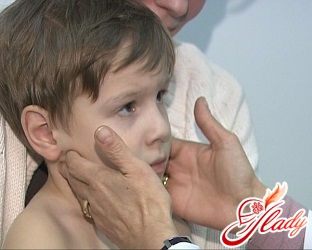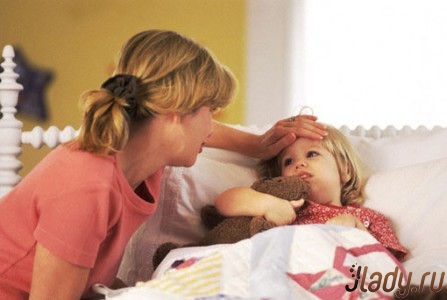 The illness of the child is the most unpleasant thing that canbe. But if chickenpox or a common cold does not pose a threat to the child, some other diseases, with no proper attention from the parents, can lead to very negative consequences for the child's organism. One such disease is inflammation of the lymph nodes or lymphadenitis. It occurs in the event that the organism of the child has a pathogenic effect of any infection. After all, lymph nodes are nothing more than protective barriers of the body. Strictly speaking, lymphadenitis is more often than not an independent disease, but only a testament to the underlying disease. For example, inflamed cervical lymph nodes in children may indicate the presence of angina or laryngitis. Very often the cervical lymph nodes swell with the disease of mumps. The increase in lymph nodes is as follows. At a time when bacteria penetrate the lymphatic channels into the lymph nodes, the latter, having received information carried by immune cells, begin production of cells designed to fight infection. During this process, there is a significant increase in the size of the lymph nodes. In especially severe cases, the lymph nodes are not able to cope with the load, resulting in severe inflammation. Sometimes even a purulent process may develop - the lymph nodes not only increase, but even the skin becomes red and swollen. In some cases, inflammation is a secondary disease, but in some cases it may be primary. In this case, the infection penetrates directly into the lymph nodes, bypassing the internal organs. This often occurs when the integrity of the skin - a variety of scratches and other wounds. Very often lymph nodes become inflamed as a result of cat scratching. As a rule, in such cases, the disease begins with a pronounced general depressed state of the body, pain in the area of affected lymph nodes, very often the child's body temperature rises and even symptoms of intoxication can be observed. Parents should immediately seek medical help and in no case take any action on their own. The only thing you can do before the arrival of doctors, is to give an antipyretic drug. And then only if the body temperature is above 39 degrees. Despite the fact that the most common causes of inflammatory processes in the lymph nodes are infections, yet there are cases when the fault becomes malignant formation. In the event that there are malignant neoplasms in the body, the lymph nodes take on the function of so-called "biological filters", not allowing cancer cells to actively spread throughout the body. This explains why, when removing tumors and metastases, all nearby lymph nodes are always removed. This significantly reduces the risk of relapse - the re-development of cancerous tumors. The same applies to cases of leukemia - irradiation of the nodes is mandatory for the successful treatment of the child. Of course, in the vast majority of cases, the reason for the increased cervical lymph nodes in a child, and any other, is a banal inflammation. However, with the inflammatory process, it is necessary to fight only under the strict supervision of a doctor. If something goes wrong in the treatment, the doctor will immediately notice this and take the necessary measures. Before more details about which group of lymph nodes are inflamed with specific diseases, it is necessary to acquaint the reader with the morphology of the human lymphatic system. The formation of the lymphatic system is finally completed only after the birth of the child. In newborn babies, the capsule, in which the lymph nodes are located, is thin, and the tuberculosis is still underdeveloped. The nodes themselves are very small, with palpation almost not palpable, because they have a very, very soft consistency. Approximately to the 6th month of life there is not only an increase in lymph nodes in size, but also an increase in their number. Normally, to feel the lymph nodes becomes, perhaps, only by the end of the first year of life of the child. At palpation it is necessary to take into account the fact that the formation of lymph nodes in children of the first years of life is not completed - the valves are not completely formed, in their place - constrictions. That is why lymph nodes during palpation have a clear, clearly expressed specific structure. Already to about 3 years the connective capsule of the lymph node becomes pronounced, with impregnations of the reticular cells. And by the age of 8, the process of formation of tuberculosis and additional lymphatic vessels begins to occur in the lymph nodes. The number of lymph nodes continues to increase until puberty, after which the reverse process begins. The greatest number of nodes in a child is about 10 years old. Perform their protective function and respond to the infiltration of infectious agents lymph nodes begin with about three months of life of the baby. At the age of one and a half years for some time this process is suspended, which is explained by the generalization of the infection. The most common lymphadenitis occurs in children aged 5 to 7 years, since it is at this age that the lymph nodes become a powerful barrier to various infectious agents. It is also at this age that up to 70% of all purulent lymphadenitis occurs. And only by 8 - 9 years the body acquires the ability to suppress infection in the lymph node itself, and their suppuration occurs less and less.
The illness of the child is the most unpleasant thing that canbe. But if chickenpox or a common cold does not pose a threat to the child, some other diseases, with no proper attention from the parents, can lead to very negative consequences for the child's organism. One such disease is inflammation of the lymph nodes or lymphadenitis. It occurs in the event that the organism of the child has a pathogenic effect of any infection. After all, lymph nodes are nothing more than protective barriers of the body. Strictly speaking, lymphadenitis is more often than not an independent disease, but only a testament to the underlying disease. For example, inflamed cervical lymph nodes in children may indicate the presence of angina or laryngitis. Very often the cervical lymph nodes swell with the disease of mumps. The increase in lymph nodes is as follows. At a time when bacteria penetrate the lymphatic channels into the lymph nodes, the latter, having received information carried by immune cells, begin production of cells designed to fight infection. During this process, there is a significant increase in the size of the lymph nodes. In especially severe cases, the lymph nodes are not able to cope with the load, resulting in severe inflammation. Sometimes even a purulent process may develop - the lymph nodes not only increase, but even the skin becomes red and swollen. In some cases, inflammation is a secondary disease, but in some cases it may be primary. In this case, the infection penetrates directly into the lymph nodes, bypassing the internal organs. This often occurs when the integrity of the skin - a variety of scratches and other wounds. Very often lymph nodes become inflamed as a result of cat scratching. As a rule, in such cases, the disease begins with a pronounced general depressed state of the body, pain in the area of affected lymph nodes, very often the child's body temperature rises and even symptoms of intoxication can be observed. Parents should immediately seek medical help and in no case take any action on their own. The only thing you can do before the arrival of doctors, is to give an antipyretic drug. And then only if the body temperature is above 39 degrees. Despite the fact that the most common causes of inflammatory processes in the lymph nodes are infections, yet there are cases when the fault becomes malignant formation. In the event that there are malignant neoplasms in the body, the lymph nodes take on the function of so-called "biological filters", not allowing cancer cells to actively spread throughout the body. This explains why, when removing tumors and metastases, all nearby lymph nodes are always removed. This significantly reduces the risk of relapse - the re-development of cancerous tumors. The same applies to cases of leukemia - irradiation of the nodes is mandatory for the successful treatment of the child. Of course, in the vast majority of cases, the reason for the increased cervical lymph nodes in a child, and any other, is a banal inflammation. However, with the inflammatory process, it is necessary to fight only under the strict supervision of a doctor. If something goes wrong in the treatment, the doctor will immediately notice this and take the necessary measures. Before more details about which group of lymph nodes are inflamed with specific diseases, it is necessary to acquaint the reader with the morphology of the human lymphatic system. The formation of the lymphatic system is finally completed only after the birth of the child. In newborn babies, the capsule, in which the lymph nodes are located, is thin, and the tuberculosis is still underdeveloped. The nodes themselves are very small, with palpation almost not palpable, because they have a very, very soft consistency. Approximately to the 6th month of life there is not only an increase in lymph nodes in size, but also an increase in their number. Normally, to feel the lymph nodes becomes, perhaps, only by the end of the first year of life of the child. At palpation it is necessary to take into account the fact that the formation of lymph nodes in children of the first years of life is not completed - the valves are not completely formed, in their place - constrictions. That is why lymph nodes during palpation have a clear, clearly expressed specific structure. Already to about 3 years the connective capsule of the lymph node becomes pronounced, with impregnations of the reticular cells. And by the age of 8, the process of formation of tuberculosis and additional lymphatic vessels begins to occur in the lymph nodes. The number of lymph nodes continues to increase until puberty, after which the reverse process begins. The greatest number of nodes in a child is about 10 years old. Perform their protective function and respond to the infiltration of infectious agents lymph nodes begin with about three months of life of the baby. At the age of one and a half years for some time this process is suspended, which is explained by the generalization of the infection. The most common lymphadenitis occurs in children aged 5 to 7 years, since it is at this age that the lymph nodes become a powerful barrier to various infectious agents. It is also at this age that up to 70% of all purulent lymphadenitis occurs. And only by 8 - 9 years the body acquires the ability to suppress infection in the lymph node itself, and their suppuration occurs less and less.
Enlargement of lymph nodes in various diseases
 As mentioned earlier, often lymph nodesincrease with various infectious diseases and diseases of internal organs. For example, occipital lymph nodes in children increase with such diseases as:
As mentioned earlier, often lymph nodesincrease with various infectious diseases and diseases of internal organs. For example, occipital lymph nodes in children increase with such diseases as:
- Toxoplasmosis.
- Infectious mononucleosis.
- The rash is crustacean.
- Rubella.
The above list only the most commondisease. With toxoplasmosis, not only occipital lymph nodes increase, but sometimes inguinal. In size, the lymph node can reach up to the size of the hazelnut. However, despite this, the nodes, as a rule, are soft, painless when palpated. They are almost never overtaxed and quickly come to normal. If a child becomes infected with infectious mononucleosis, almost all groups of lymph nodes are enlarged, but the most pronounced inflammatory process is lymph nodes on the back of the child. The enlarged lymph nodes are visible even without palpation, the child often has lymphostasis and swelling of the face, pronounced painful sensations. Almost the same thing happens in the event that a child develops rubella. Lymph nodes increase in size and are painful when pressed. Suppuration of the lymph nodes does not occur almost never, but lymphadenitis is a very common consequence of rubella. Lymph nodes in the groin of children become inflamed with damage to the integrity of the skin of the legs. Very often inflammation develops not immediately after skin damage, but after two to three weeks. Infection penetrates into the lymph node, and some time is in an inactive state. And only after a while the lymph node begins to swell. In some cases, the body copes with the infection, and the swelling dissolves itself. But in some cases inguinal lymphonoduses in children can rot and need the help of a surgeon. It is very important to pay attention to all damage to the integrity of the skin and immediately treat them properly. This will help prevent a situation where a small scratch turns into a big headache. Also, the cause of inflammation of the lymph nodes in the groin in children can be:
- Severe course of diarrhea with numerous ulcers of the skin.
- The presence of boils in the buttocks.
- In some cases, inflammation of the lymph nodes can occur as a result of BCG vaccination, including
- case if the vaccine was injected into the hip.
In addition, the lymph nodes on the head of the childIncrease in the presence of inflammation in the middle and outer ear, furunculosis of the scalp, in some cases with allergic dermatitis. As a rule, in this case, there are enlarged lymph nodes behind the ears of children. Also, the increase in lymph nodes on the head in a child occurs with diphtheria of tonsils or streptococcal angina - these are the most dangerous cases for the baby's health. In the event that there are abscesses and other dental diseases, various stomatitis - there is inflammation of the lymph nodes in the chin zone. Lymph nodes in armpits in children become inflamed with various diseases and wounds of the skin in the arms and shoulders. In the overwhelming majority of cases, the cause of inflammation is the so-called "cat scratch disease". In medicine, this disease is called "benign lymphoreticulosis." The illness proceeds as follows: after the cat scratches the baby, there is inflammation of that lymph node, which is closest to the scratch, which is the gateway to infection. In the event that a cat was scratched by a cat, the wound should be immediately treated with greens or iodine and for some time carefully monitored the condition of the baby. In some cases, toxoplasmosis can also be accompanied by inflammation of the lymph nodes in the armpits in children. If you notice inflammation of the lymph nodes in children, the treatment should begin immediately and only on the prescription of the doctor and under his strictest control. As a rule, in cases when lymphadenitis started due to infection, antibiotics are very effective. Lymphonoduses very quickly return to their normal size, soreness disappears, and blood counts return to normal. Very often, parents, on the advice of friends, begin to warm up the inflamed lymph nodes in every way. However, this should not be done in any case, as it can lead to the appearance of severe suppuration and even infection. That is why it is permissible to warm up only according to the doctor's prescription and only in the conditions of a medical institution. If you have inflamed lymph nodes in children, treatment should be directed not at the lymph node itself, but primarily on the underlying disease. Unfortunately, in some cases the doctor can not diagnose only on the basis of complaints from parents and the baby himself, and sometimes the results of the analyzes do not clarify the picture. In this case, the doctor should appoint an ultrasound examination of the affected lymph node, as well as internal organs - the spleen, liver, abdominal lymph nodes. If the diagnosis can not be made after this, the doctor will prescribe an X-ray study, a study on the latent course of tuberculosis infection. If the doctor suspects the presence of pathogens of CMV, herpes or toxoplasmosis in the blood of the child, he will prescribe a laboratory serological blood test. If this does not clarify the nature of the inflammation of the lymph node, the only way out is to perform a puncture and subsequent biopsy of the lymph node. In any case, parents should in no case ignore the inflammation of the lymph nodes. Of course, it is not necessary to panic and be frightened, since most often the cause of inflammation is absolutely banal and easily amenable to treatment. However, there are times when you can not do without medical assistance. Of course, parents can not objectively assess the state of the child and the cause of the disease. It is much more reasonable to provide the possibility of diagnosis and treatment to doctors. We advise you to read:








